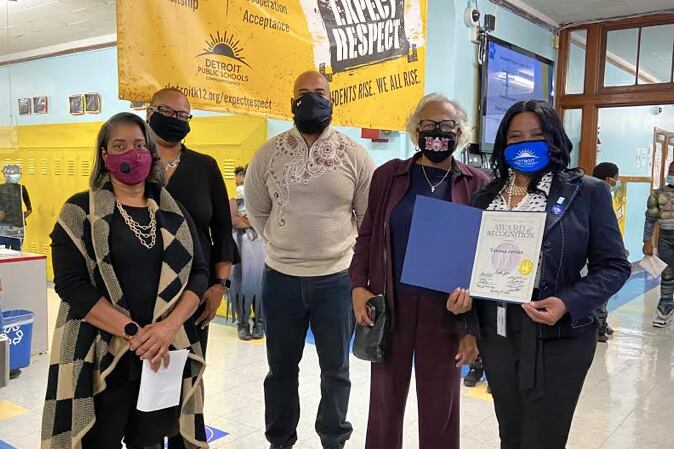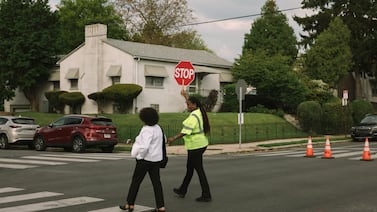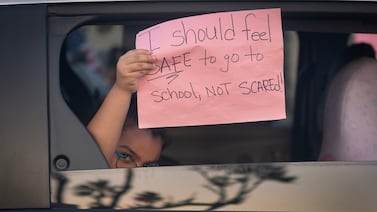English language arts teacher Tawana Jordan often gives her fourth grade students a tour of her house to help them feel more comfortable in her virtual classroom. She’ll show students around the room where she teaches. Sometimes, her wiener dog, Oscar, makes a surprise cameo, much to the delight of her students at Burns Elementary-Middle School.
Whether in person or on screen — the Detroit district will be fully remote until at least January — Jordan seeks to create an atmosphere that is engaging, respectful, and where all students “feel like they’re the teacher’s pet.” She emphasizes that there are no wrong answers in her classroom, since she wants students to express their ideas with confidence and without fear of judgment. When students feel safe and welcomed in the classroom, they perform better academically, Jordan said.
In October Jordan received the Klingenstein Teacher Award, honoring exemplary English language arts educators. At Burns, Jordan has been a master teacher for three years. That means she spends half the day teaching students and the other half observing, coaching, and mentoring early-career or student teachers.
Chalkbeat spoke with Jordan on increasing participation during remote learning, navigating difficult conversations about the presidential election, and collaborating with other teachers to foster student progress.
This interview has been lightly edited for length and clarity.
How do you connect with your students?
Just getting to know them, how they learn, and what they need. I want them to be able to read and become a productive citizen. But I also want them, most importantly, to feel good about themselves and who they are as a person. So when I learn who they are, and I teach to that, it builds a relationship. They feel like they’re important to me, which they absolutely are, so they learn better in my class.
How have you adapted to teaching virtually? What has been helpful so far?
I’m familiar with a lot of kids already in the school, and the kids already knew me. That was an advantage when I started teaching virtually. I had already built this relationship with the kids. That’s the hard part of teaching virtually. We still have to build trust, and we still have to build relationships with kids even over the computer.

Being at home, I would show the kids my room. Here’s my dog. Sometimes kids think you live in the school building. I’m just a normal person, too. The kids love to show their favorite toy. It feels like a family connection. Sometimes kids feel like they’re the only people who live in this isolation. Of course, some don’t feel comfortable showing that environment.
We don’t require them to turn on their camera. But I have taught my students how to build a virtual background. We do want to see your face. Your classmates want to see you. We want to talk to you, and make that connection and build confidence. We don’t make fun of each other. I teach my kids that we are who we are. I don’t have to be ashamed of anything that I am.
What is your favorite lesson to teach? This can be current or pre-COVID. Where did the idea come from?
It’s about human rights. The students read a book called “Esperanza Rising.” They’re in Mexico, and Esperanza and her family are coming to America. It’s just really a good story about human rights and how to treat each other correctly. They are a part of history, too. I attended a historically Black college, and they ingrained history and human rights in every lesson.
Why did you decide to become a teacher?
Well, my mother was a teacher for Detroit Public Schools for over 30 years. She retired, and she’s deceased now. She always was just into education and helping the community. And in fact, I think that was my first teaching job, tutoring the kids in the neighborhood. As a young child, I just always was interested in education and helping others learn. I just saw that joy of helping students. I just knew that’s what I wanted to be.
What’s something that’s been happening in the community or in the nation that affects what’s going on in your class right now?
This was my students’ first election [that they remember]. They believed that everybody thinks like them. They just believed that everybody was gonna vote for Joe Biden. It is my job to give them perspective, and make them look at everybody’s perspective and make them feel like, ‘My voice is important.’ But other people’s voices and opinions are important, too. So when we do that, we kind of eliminate hatred that comes from not knowing or not having empathy for other people.
What is your advice to new teachers?
Starting with the end goal in mind, ‘What is my end for this lesson today?’ and also looking at student data. I know, as teachers, we sometimes don’t have time to look at data. We just turn page by page through lesson one, lesson two, and just keep going. But when we can isolate and teach with intention, that helps our students.
We have to be able to trust our coworkers. If I’m teaching third grade, I have to trust that the second grade teacher did her job. I have to trust you in order to move these kids along. We have to pass this torch. So we have to work together. Good teaching in isolation does not help students. It’s all about a connection between teachers. This is a marathon, and we all have to take part in it. It’s better for kids.
Are there lessons you’ve learned about teaching English virtually?
We have to learn how to give ourselves grace as we’re teaching. This lesson did not go as planned, and it’s okay. Or my technology did not work; I couldn’t share my screen, and it’s okay. We are doing our best, and we can’t control every app, but I’m still having an impact on my kids.







